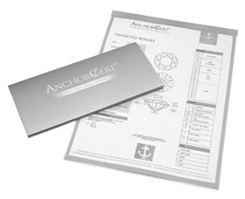
AnchorCert is the only UK based Diamond and Gemstone Certification, Grading and Testing service which is backed by the professional expertise and experience of the Birmingham Assay Office.
AnchorCert Diamond gemstone Certification is provided by highly qualified Gemmologists and diamond Graders from its Centre of Excellence in Birmingham.
AnchorCert has a fully equipped diamond grading laboratory that uses the industry's leading state-of-the-art gemmological instruments. These range from the tried and tested 10 x diamond magnification lenses to the sophisticated Raman spectrometer. Continuing technological investment keeps the laboratory at the forefront of diamond grading in the UK.
The Mini Report is highly popular and a competitively priced report. It presents the diamond characteristics in a simple format and includes a digital image of the stone or piece of jewellery. A Mini Report is suitable for loose, mounted and multi-set diamond jewellery. Important quality information included on the report is weight, shape, measurements, colour and clarity.
The full report presented as an A4 sheet with a facet diagram. Is a comprehensive report suitable for loose un-mounted diamonds. It provides detailed information and expert opinion on all aspects of the stone.
 Details included on the full report are weight, measurements, colour, clarity, symmetry, polish, fluorescence, girdle description, shape and cut grade for round brilliants. The report also outlines details of the facet angles and proportions of the diamond. All inclusions are plotted on the facet diagram which uniquely identifies the stone. The full report provides where appropriate the proportion table for fancy cuts.
Details included on the full report are weight, measurements, colour, clarity, symmetry, polish, fluorescence, girdle description, shape and cut grade for round brilliants. The report also outlines details of the facet angles and proportions of the diamond. All inclusions are plotted on the facet diagram which uniquely identifies the stone. The full report provides where appropriate the proportion table for fancy cuts.
The A5 full report without facet diagram is only available for loose stones. The short report contains all the information and opinion provided in the full report, minus the detailed facet diagram. It has been developed as a midpoint between the Full report and the mini report.
The Full reports include a UKAS accreditation logo and also carry the unique anchor hologram to prevent forgery and copying.
Every diamond is unique and has a beauty all of its own. There is a huge choice available- something to suite every budget. The factors that influence the value are clarity, colour, cut and carat.
 An unskilled eye may struggle to differentiate between two colour grades. AnchorCert have qualified gemmologists that can accurately classify diamonds according to internationally recognised colour grading scales. The colour scale starts at D and ends at Z.
An unskilled eye may struggle to differentiate between two colour grades. AnchorCert have qualified gemmologists that can accurately classify diamonds according to internationally recognised colour grading scales. The colour scale starts at D and ends at Z.
Round brilliant cut diamonds are the most popular diamond cut. Traditionally a round brilliant diamond has 58 facets. The facets are aligned at precise angles in relation to each other to maximize the light reflected through the diamond. The shape of the finished diamond will vary according to the natural characteristics of the rough stone and the skill of the cutter. It is one of the most important aspects of a diamond. The quality of cut will significantly affect the look and therefore the value of your diamond.
Diamonds are also cut in other shapes, depending on the original form of the rough diamond. These include emerald, heart, marquise, oval, and princess cut.
It is rare to find a flawless diamond. Most diamonds contain tiny imperfections, called inclusions, which are created by nature and make every diamond unique. Inclusions can range from minute dark or light solid fragments, crystals, cleavages, fractures and feathers. Many inclusions are invisible to the naked eye and can only be assessed by a gemmologist using magnification.
Diamond weight is measured in carats; one carat is divided into 100 points, so for example, a diamond weighing half a carat can also be described as weighing 50 points or 0.50 carats.
A diamond is the hardest substance found in nature. It is resistant to damage by heat or scratching and can be cut or polished only by another diamond. However, a blow to the diamond can cause a diamond to chip. Exposure during ordinary wear to perspiration and household chemicals such as chlorine and hairspray can cause build up that dulls the surface of a diamond. Periodic cleaning is suggested to keep the diamond brilliant and refractive.
